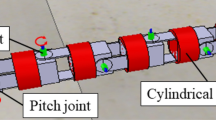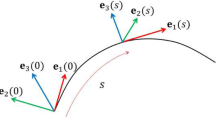Abstract
Modular snake robot has the ability to maneuver narrow, complex, and unstructured environments. In recent years, Snake robot with 3-D locomotion has been studied by researchers for inspection of pipes, and stairs climbing etc. One of the effective approaches to accomplishing such complex tasks is by designing gaits for modular snake robot. In this paper, A Spiral curve gait along with rolling motion is proposed to adapt to the changes in the pipe diameter while moving on the pipe, which cannot be overcome by a simple helical rolling motion. The joint angles are calculated using Bellow’s model, based on the curvature and torsion of the backbone curve. We validated the proposed gait by simulating thirty degrees of freedom modular snake robot in Open Dynamics Engine simulator.
Similar content being viewed by others
References
S. Hirose, Biologically Inspired Robots: Serpentile Locomotors and Manipulators, Oxford University Press, 240, 1993.
P. Liljebäck, K. Y. Pettersen, Ø. Stavdahl, and J. T. Gravdahl, “A review on modelling, implementation, and control of snake robots,” Robotics and Autonomous Systems, vol. 60, no. 1, pp. 29–40, 2012.
M. Mori and S. Hirose, “Development of active cord mechanism ACM-R3 with agile 3D mobility,” Proceedings of IEEE/RSJ International Conference on Intelligent Robots and Systems, Expanding the Societal Role of Robotics in the the Next Millennium (Cat. No.01CH37180), 2001.
H. Yamada and S. Hirose, “Study on the 3D shape of active cord mechanism,” Proceedings of IEEE International Conference on Robotics and Automation, 2006.
K. Lipkin, I. Brown, A. Peck, H. Choset, J. Rembisz, P. Gianfortoni, and A. Naaktgeboren, “Differentiable and piecewise differentiable gaits for snake robots,” Proc. of IEEE/RSJ International Conference on Intelligent Robots and Systems, 2007.
C. Wright, A. Johnson, A. Peck, Z. McCord, A. Naaktgeboren, P. Gianfortoni, M. Gonzalez-Rivero, R. Hatton, and H. Choset, “Design of a modular snake robot,” Proc. of IEEE/RSJ International Conference on Intelligent Robots and Systems, 2007.
M. Tesch, K. Lipkin, I. Brown, R. Hatton, A. Peck, J. Rembisz, and H. Choset, “Parameterized and scripted gaits for modular snake robots,” Advanced Robotics, vol. 23, no. 9, pp. 1131–1158, 2009.
J. W. Burdick, J. Radford, and G. S. Chirikjian, “A’ sidewinding’ locomotion gait for hyper-redundant robots,” Advanced Robotics, vol. 9, no. 3, pp. 195–216, 1994.
R. L. Hatton and H. Choset, “Generating gaits for snake robots: annealed chain fitting and keyframe wave extraction,” Autonomous Robots, vol. 28, no. 3, pp. 271–281, 2010.
H. Yamada and S. Hirose, “Approximations to continuous curves of active cord mechanism made of arc-shaped joints or double joints,” Proceedings of IEEE International Conference on Robotics and Automation, 2010.
T. Kamegawa, T. Harada, and A. Gofuku, “Realization of cylinder climbing locomotion with helical form by a snake robot with passive wheels,” Proceedings of IEEE International Conference on Robotics and Automation, 2009.
T. Baba, Y. Kameyama, T. Kamegawa, and A. Gofuku, “A snake robot propelling inside of a pipe with helical rolling motion,” Proceedings of the SICE Annual Conference, 2010.
T. Kamegawa, T. Baba, and A. Gofuku, “V-shift control for snake robot moving the inside of a pipe with helical rolling motion,” Proc. of 9th IEEE International Symposium on Safety, Security, and Rescue Robotics, 2011.
W. Qi, T. Kamegawa, and A. Gofuku, “Proposal of helical wave propagate motion for a snake robot to across a branch on a pipe,” Proc. of IEEE/SICE International Symposium on System Integration, 2017.
W. Zhen, C. Gong, and H. Choset, “Modeling rolling gaits of a snake robot,” Proceedings of IEEE International Conference on Robotics and Automation, 2015.
T. Takemori, M. Tanaka, and F. Matsuno, “Gait design for a snake robot by connecting curve segments and experimental demonstration,” IEEE Transactions on Robotics, vol. 34, no. 5, pp. 1384–1391, 2018.
M. Vespignani, K. Melo, M. Mutlu, and A. J. Ijspeert, “Compliant snake robot locomotion on horizontal pipes,” Proc of IEEE International Symposium on Safety, Security, and Rescue Robotics, 2016.
Y. Zhou, Y. Zhang, F. Ni, and H. Liu, “A spring-like pipe climbing gait for the snake robot,” Proc. of IEEE International Conference on Robotics and Biomimetics (ROBIO), 2017.
G. Harary and A. Tal, “The natural 3D spiral,” Computer Graphics Forum, vol. 30, no. 2, pp. 237–246, 2011.
H. Streich and O. Adria, “Software approach for the autonomous inspection robot MAKRO,” Proc. of IEEE International Conference on Robotics and Automation, 2004.
B. Klaassen and K. L. Paap, “GMD-SNAKE2: a snakelike robot driven by wheels and a method for motion control,” Proc. of IEEE International Conference on Robotics and Automation, vol. 4, pp. 3014–3019, 1999.
R. Smith, “Open Dynamics Engine,” http://www.ode.org, online, 2014.
Author information
Authors and Affiliations
Corresponding author
Additional information
Publisher’s Note Springer Nature remains neutral with regard to jurisdictional claims in published maps and institutional affiliations.
Recommended by Editor Fumitoshi Matsuno. This research was supported by the Higher Education Commission of Pakistan by the award letter No. HRDI-UESTPs/Batch-IV/Korea/2016/1379
Sheraz Yaqub received his B.Sc. degree in Mechatronics Engineering from University of Engineering and Technology (U.E.T.) Taxila, Chakwal campus, Pakistan in 2013. He is currently pursuing a masters leading to Ph.D. in Mechatronics at Hanyang University, Korea. His research interests include Robot Motion Planning, Control Theory, Redundant Robots.
Ahmad Ali received his B.Sc. Engineering Degree in Mechatronics and Control Engineering in 2006 from University of Engineering and Technology, Lahore, Pakistan and MS Degree in Automation and Control Technologies in 2011 from Politecnico di Torino, Italy. Currently, he is a Ph.D. student in CnR lab at Hanyang University, Korea. His research interests are Systems Analysis, Nonlinear Control Theory, Geometric Control of Mechanical Systems, and Motion Planning for Nonholonomic System.
Muhammad Usman received his BSc degree in Mechatronics and Control Engineering from University of Engineering and Technology (U.E.T.) Lahore, Pakistan in 2008. He worked for an Automation company for three months in 2009. Since September 2009, he has been working as a lecturer in Mechatronics and Control Engineering Department in University of Engineering and Technology Lahore (Faisalabad Campus), Pakistan. He received his MSc Mechatronics degree from National University of Singapore in 2012 and restored his teaching job in U.E.T. He is currently on study leave and pursuing his Ph.D. in Mechatronics at Hanyang University, Korea. His research interests include Autonomous vehicles, SLAM, Data association, Navigation and Control.
Khalil Muhammad Zuhaib received his B.E. degree in Electronics Engineering from Quaid-e-Awam University, Pakistan in 2009, and his Masters leading to Ph.D. in Mechatronics Engineering from Hanyang University, 2018, Korea. In March 2018, he joined Quaid-e-Awam University College of Engineering and Technology, Larkana, Pakistan where he is currently working as an Assistant Professor in the Department of Electronic Engineering. His current research interests include multi-robot systems and robot motion planning.
Abdul Manan Khan received his B.Sc. and M.Sc. degrees in Mechatronics and Control Engineering from University of Engineering and Technology, Lahore, Pakistan, in 2007 and 2010, respectively, and his Ph.D. degree in Mechanical Design Engineering from Hanyang University, 2016, Korea. Currently, he is Assistant Professor in Department of Mechatronics Engineering, University of Engineering and Technology, Taxila, Pakistan. His research interests include rehabilitation and assist exoskeleton robots. He has worked in many projects including lower limb and upper limb assist exoskeleton robots. He is also interested in working on motion planning based different task executions and control. He also has expertise in Robotic Operating System (ROS) and C++.
Boyoung An received her B.Sc degree in Bio Medical Engineering in 2013 from Inje University and her M.S. degree in Bio Medical Engineering in KyungHee University in 2015. Currently, She is a Ph.D. candidate in the Department of Mechatronics Engineering at Hanyang University. Her research interest is robotics and control, Performance Analysis, and mechanism design.
Hyungi Moon received his bachelor’s degree in Mechanical Design and Automation Engineering, Seoul National University of Science and Technology, Korea in 2012. He is currently in the process of integrated master-doctor degree in Mechanical Engineering at Hanyang University, Korea. His research interests include robot control theory and mechanical design of Exoskeleton.
Ji Yeong Lee received his B.Sc. and M.Sc. degrees in Mechanical Engineering from Seoul National University, Korea, in 1991 and 1993, respectively, and his Ph.D. degree in Mechanical Engineering from Carnegie Mellon University, USA, in 2003. From 1993 to 1998, he was researcher in Automation Research Institute, Samsung Electronics, Korea. From 2003 to 2007, he was senior researcher in department of Mechanical Engineering, KAIST, Korea. In 2007, he joined Hanyang University, South Korea. Currently, he is Associate Professor in Department of Robotics Engineering, Hanyang University. His research interests include robotics and control, path planning, Articulated robots and nonholonomic systems.
Changsoo Han received his B.S. degree in Mechanical Engineering from Hanyang University in 1983, and his M.S. and Ph.D. degrees in Mechanical Engineering from University of Texas at Austin, in 1985, 1989, respectively. From September 1984 to May 1985, he was a Teaching Assistant with CAD/CAM Lab in the department of engineering of the University of Texas at Austin. From October 1987 to April 1988, he was the consultant for a Lockheed MAC design project for the Lockheed Austin Division. From May 1988 to September 1989, he was a research assistant, Robotics Lab in mechanical engineering manufacturing of the high-resolution micromanipulator. He stayed at University of California at Berkeley as a visiting professor from August 1996 to July 1997. In March 1990, he joined Hanyang University, Ansan, Korea as an assistant professor in the department of mechanical engineering. Currently, he is a Professor in the Department of robot engineering, Hanyang University. His research interests include intelligence service robot, high precision robotics and mechatronics, rehabilitation and biomechanics technology using robotics, automation in construction, advanced vehicle control and assistive exoskeleton robots.
Rights and permissions
About this article
Cite this article
Yaqub, S., Ali, A., Usman, M. et al. A Spiral Curve Gait Design for a Modular Snake Robot Moving on a Pipe. Int. J. Control Autom. Syst. 17, 2565–2573 (2019). https://doi.org/10.1007/s12555-019-0074-9
Received:
Revised:
Accepted:
Published:
Issue Date:
DOI: https://doi.org/10.1007/s12555-019-0074-9




